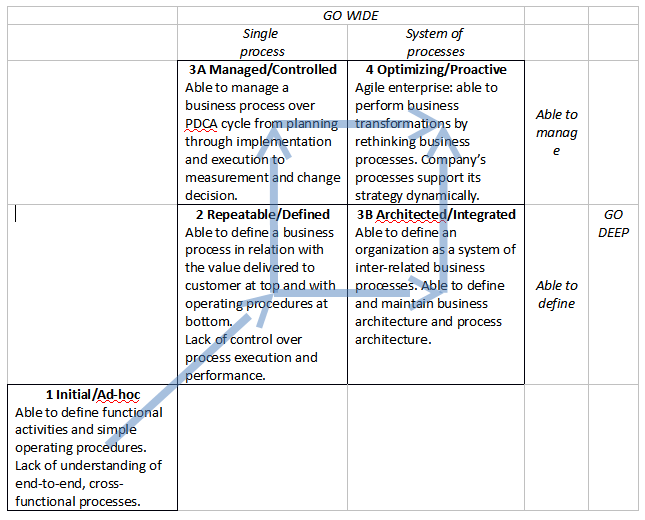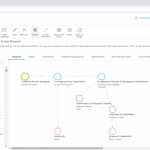BPM Maturity Model: Go Deep vs. Go Wide Strategy
April 12, 2023
Virtually every company becomes caught by the business process idea, sooner or later. The BPM promises – sales up! costs down! unprecedented agility! – make people eager to implement the “BPM thing” as soon as possible, if not yesterday
The process maturity model is probably the most underappreciated concept of the Business Process Management discipline.
Virtually every company becomes caught by the business process idea, sooner or later. The BPM promises – sales up! costs down! unprecedented agility! – make people eager to implement the “BPM thing” as soon as possible, if not yesterday.
But here is the trap: people tend to view BPM as an ocean of opportunities where almost any course may be charted. While in reality it’s rather a railroad line named “BPM maturity scale”. Knowing the map of this line is absolutely critical because the process maturity is a part of company’s culture so it can’t be picked up arbitrary or changed easily – only step by step. One should honestly evaluate at what station the organization currently stays and then buy a ticket to the next one. Taking what seems to be a short way may derail the company’s BPM train.
The maturity model comes in many flavors: Gartner has one, Forrester has another, Carnegie-Mellon SEI has CMMI. The BPM Common Body of Knowledge by ABPMP refers all these plus Michael Hammer’s PEMM plus introduces its own model. While being in consensus on what the topmost level is, different models propose slightly different paths to the “process nirvana”.
Let’s have a closer look. The table below aligns the models by the top level – “Optimized” or “Proactively Managed”:
Table 1. Well-known process maturity models
Organizations moving along the maturity scale shall overcome two barriers:
1) “Go wide” – increasing the scope of process work: from selected priority processes to the system of processes constituting the enterprise.
2) “Go deep” – increasing the degree of control: from basic process documenting to structured definition to full management of the business process lifecycle with strong emphasis.
These two challenges are essentially independent hence it would make more sense to present the maturity model as a two-dimensional matrix rather than a linear scale:
 Table 2. Process maturity matrix
Table 2. Process maturity matrix
The only way from the Initial/Ad-hoc level (1) is to Repeatable/Defined (2). The next move is less obvious an organization can increase the degree of control (“go deep” – 3A) or broaden the scope of BPM efforts (“go wide” – 3B) or try to combine both. Either way, the final destination (4) is the same so the question is only about what should come first.
Now let’s get back to the maturity models presented in Table 1: which path do they suggest?
Having the votes split 50 by 50, a BPM practitioner have to make a decision on his own. The first purpose of this article was to attract attention to the gateway in BPM maturity model – whatever path one would chose, it’s much better to make it with eyes open.
As for my personal recommendation, I tried both paths and this experience made me a strong believer of “Go Deep” strategy. The reason is simple – “Go Wide” strategy systematically fails because:
The process maturity model is probably the most underappreciated concept of the Business Process Management discipline.
Virtually every company becomes caught by the business process idea, sooner or later. The BPM promises – sales up! costs down! unprecedented agility! – make people eager to implement the “BPM thing” as soon as possible, if not yesterday.
But here is the trap: people tend to view BPM as an ocean of opportunities where almost any course may be charted. While in reality it’s rather a railroad line named “BPM maturity scale”. Knowing the map of this line is absolutely critical because the process maturity is a part of company’s culture so it can’t be picked up arbitrary or changed easily – only step by step. One should honestly evaluate at what station the organization currently stays and then buy a ticket to the next one. Taking what seems to be a short way may derail the company’s BPM train.
The maturity model comes in many flavors: Gartner has one, Forrester has another, Carnegie-Mellon SEI has CMMI. The BPM Common Body of Knowledge by ABPMP refers all these plus Michael Hammer’s PEMM plus introduces its own model. While being in consensus on what the topmost level is, different models propose slightly different paths to the “process nirvana”.
Let’s have a closer look. The table below aligns the models by the top level – “Optimized” or “Proactively Managed”:
| SEI CMMI | Gartner | Forrester | ABPMP |
| 0: Acknowledge Operational Inefficiencies | 0: Non-Existent | ||
| 1: Initial | 1: Process-Aware | 1: Ad Hoc | 0: Ad-Hoc |
| 2: Managed | 2: Intra-Process Automation and Control (Coordinated Processes) | 2: Repeatable | 1: Defined |
| 3: Defined | 3: Inter-Process Automation and Control (Cross-Boundary Process Management) | 3: Defined | 2: Controlled |
| 4: Quantitatively Managed | 4: Enterprise Valuation Control (Goal-Driven Processes) | 4: Measured | 3: Architected |
| 5: Optimizing | 5: Agile Business Structure (Optimized Processes) | 5: Optimized | 4: Proactively Managed |
Organizations moving along the maturity scale shall overcome two barriers:
1) “Go wide” – increasing the scope of process work: from selected priority processes to the system of processes constituting the enterprise.
2) “Go deep” – increasing the degree of control: from basic process documenting to structured definition to full management of the business process lifecycle with strong emphasis.
These two challenges are essentially independent hence it would make more sense to present the maturity model as a two-dimensional matrix rather than a linear scale:
 Table 2. Process maturity matrix
Table 2. Process maturity matrix The only way from the Initial/Ad-hoc level (1) is to Repeatable/Defined (2). The next move is less obvious an organization can increase the degree of control (“go deep” – 3A) or broaden the scope of BPM efforts (“go wide” – 3B) or try to combine both. Either way, the final destination (4) is the same so the question is only about what should come first.
Now let’s get back to the maturity models presented in Table 1: which path do they suggest?
- In SEI CMMI “Quantitatively Managed” immediately precede the final “Optimizing” level. It means that this model prescribes broaden the scope first then increase the degree of control.
- Gartner’s model makes the emphasis on “Automation and Control” at early level 2, before widening the scope to the system of process.
- Forrester puts “Measured” immediately before “Optimized” – approach similar to CMMI (these two models are in fact pretty close).
- ABPMP puts “Controlled” before “Architected”
Having the votes split 50 by 50, a BPM practitioner have to make a decision on his own. The first purpose of this article was to attract attention to the gateway in BPM maturity model – whatever path one would chose, it’s much better to make it with eyes open.
As for my personal recommendation, I tried both paths and this experience made me a strong believer of “Go Deep” strategy. The reason is simple – “Go Wide” strategy systematically fails because:
- People just don’t understand what the business process is until they’ve got experience in managing it all over PDCA cycle – and speedy enough! Without the deep understanding of these fundamental things the process map a company may develop as part of “go wide” effort probably would be flawed; the chances are big that it’d be yet another catalog of business functions rather than a true business process architecture based on an enterprise value chain.
- A business process well-defined yet not put into the environment granting tight control over execution, automatic monitoring and agility is too expensive in terms of management. A qualified manager will have to spend a big part of his working time to assure that process participants act in accordance with the process definition and workplace instructions and to gather process metrics semi-manually. It’s a pure mechanical job that should be trusted to a software robot (yes, I’m promoting BPMS here). An attempt to widen the BPM initiative without such tools would exhausts the management resources pretty fast.
- A process defined yet left unmanaged due to lack of management resources becomes just a wishful dream that have little connection to how the work is really done in the organization. The more processes we defined and left them unmanaged – the deeper we are “paralyzed by analysis”: processes changes faster than we are able to analyze these changes, leaving alone to manage these changes proactively.


